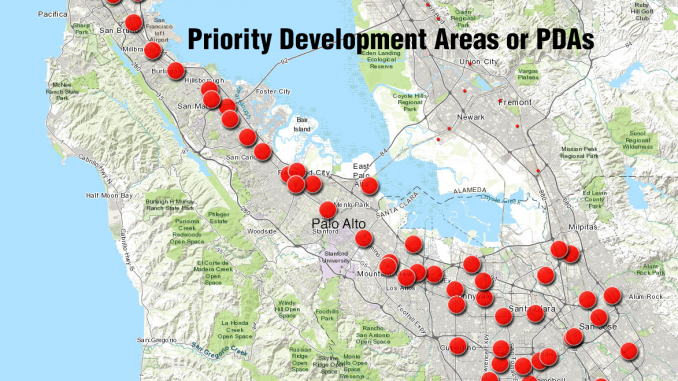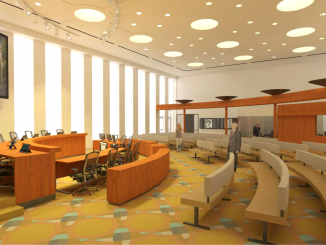
BY ELAINE GOODMAN
Daily Post Correspondent
More than a decade ago, Bay Area regional planning agencies launched a growth strategy intended to concentrate new jobs and housing at designated sites close to transit — so-called Priority Development Areas or PDAs.
Now, questions are being raised about whether the strategy has backfired, worsening the shortage of housing relative to jobs, lengthening commutes, and snarling traffic. Even the agencies that came up with the idea of PDAs are acknowledging that the concept may need adjustments.
The debate comes as the agencies that developed the PDA strategy — the Metropolitan Transportation Commission, or MTC, and Association of Bay Area Governments, or ABAG — have scheduled meetings this week to start discussing an update to their long-term regional plan.
The PDA concept is included in the MTC and ABAG regional plan, called Plan Bay Area 2040. The idea behind the PDAs is to reduce car trips in the Bay Area and protect open space.
But Greg Schmid, a former Palo Alto vice mayor, said that while jobs have been added in the PDAs, housing in those areas has lagged, particularly in the West Bay region between San Francisco and Santa Clara.
“MTC’s Plan Bay Area 2040 has been a major contributor to the jobs/housing growth imbalances in the West Bay,” Schmid said in a letter to the agency.
For one thing, Schmid said, the high demand for office space in the West Bay has made land that could be used for housing exorbitantly expensive. Housing that is being built is often apartments in the 600- to 800-square-foot range, which is not appealing to families, he said. As a result, many workers with families are living in the suburbs and driving to their jobs on congested freeways, he added.
And even though some workers could take transit to their jobs in the PDAs, transit lines such as Caltrain are reaching capacity, he said.
MTC’s update to Plan Bay Area 2040 will be called Plan Bay Area 2050.
Schmid said the new plan “must slow job growth and work toward a healthy balance of moderate jobs and population growth.”
In fact, a paper that MTC released last month called “The Future of Jobs” lists as one potential approach the establishment of office-development limits in areas where jobs are plentiful but housing is not. Incentives could be offered to cities to enact such limits, according to the proposal, which hasn’t been finalized.
More jobs added than homes
From 2010 and 2018, 750,000 jobs were added in the Bay Area, but only about 100,000 housing units, “contributing to the long-standing housing affordability challenge of the region,” MTC said in the paper.
Priority Development Areas are spread across the Peninsula. A map on the MTC website dated October 2018 shows a California Avenue PDA in Palo Alto, an El Camino Real PDA in Menlo Park, a Ravenswood PDA in East Palo Alto, and several PDAs in Mountain View.
It’s up to cities to designate an area as a PDA; many other areas would qualify as PDAs, but have not been designated, according to MTC.
The PDAs have been effective at keeping new development out of areas designated for open space preservation, MTC said in a paper released in February called “Regional Growth Strategies.”
Goal isn’t being met
And new housing development has shifted to the PDAs since 2014, when slightly more than 20% of Bay area homes were in those areas. By 2017, 64% of permits issued for new housing were for homes within PDAs.
But MTC said this falls short of the goal set in the agency’s regional plan, of building 77% of new housing in PDAs. And the PDAs haven’t met targets for providing affordable housing: 83% of permits issued for homes in the PDAs have been for “above moderate” income housing, while only 13% have been for low to very low income housing.
“The level of housing production — both inside and outside of PDAs — is falling far short of meeting the Bay Area’s needs,” MTC said in the paper.
The MTC paper proposes expanding the number of areas where housing is a priority, while at the same time promoting job growth closer to residents who have long commutes.
Meetings this week
MTC is planning a series of meetings this month to discuss Plan Bay Area 2050, with a focus on the agency’s methods for forecasting regional growth.
The Regional Advisory Working Group will meet to discuss the topic Tuesday (June 4) at 9:30 a.m.; followed by the Regional Planning Committee on Wednesday (June 5) at 1 p.m.; and the Planning Advisory Council on June 12 at 1:30 p.m. All meetings are at the Metro Center, 375 Beale St. in San Francisco.
Only a fraction of the local news stories covered by the Daily Post appear on this website. To get all the local news, including many stories you can’t find online, pick up the Post every morning at 1,000 Mid-Peninsula locations.




Some of us railed against ABAG and Plan Bay Area, with it’s RHNA (Regional Housing Needs Allocation) years ago – before it was ratified – and became all powerful in the region. It’s stunning that it took until 2019 for some with ABAG/MTC to – only now – admit to one of the huge follies of their agenda….that I t’s actually resulted in making the housing shortage worse. Imagine that?!?
Whoops.
This is what happens when non-elected governing bodies become all powerful. *We did not elect them to serve on ABAG or the MTC, specifically, they are elected officials who were then appointed to those positions…some may call that cronyism.
Whatever. Damage done.
Good job.
The map looks like the peninsula has measles.
Central planning by the government always fails. Remember the old Soviet Union and their “five year plans”? Same mentality as ABAG. Government knows best.
Why would you want to slow down job growth??? Build more housing. Build up.